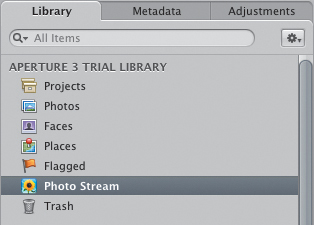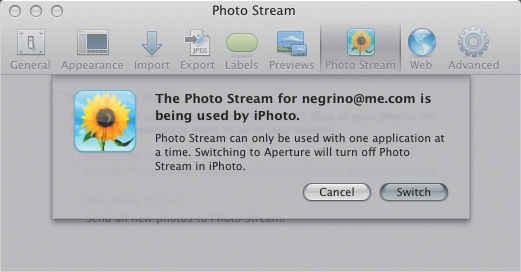5. Using iPhoto with iCloud
Photo Stream, part of the iCloud service, solves a familiar problem. You take a photo here, but you’d like to view it or work on it over there. For example, you might have taken a picture with your iPhone (following the ancient adage that the best camera is the one that you have with you), then want to add it to your iPhoto library on your Mac. Or maybe you imported a bunch of pictures into iPhoto from your digital camera, and you’d like to show them off to people using your iPad. With Photo Stream, your new photos will be uploaded to the iCloud servers and will automagically be pushed to your other iCloud-enabled devices when they are connected to Wi-Fi.
On the Mac, Photo Stream works with Apple’s iPhoto or Aperture programs. Since those programs don’t exist on Windows, you can designate automatic download and upload folders on your PC’s hard disk for use with Photo Stream.
Setting up Photo Stream in iCloud
Photos uploaded to Photo Stream are stored in iCloud for 30 days. Your iOS devices keep a rolling collection of the last 1,000 photos in your Photo Stream, in order to make the best use of their limited storage. Since computers generally have way more storage space than mobile devices, all of the photos that are part of your Photo Stream are kept on your Mac or PC, even if you shoot more than 1,000 photos in a month.
Photo Stream supports JPEG, TIF, PNG, and most RAW photo formats. On a computer, your photos will be downloaded and stored in full resolution. iCloud delivers photos to your iOS device (iPhone, iPad, iPod touch, and Apple TV), in a reduced resolution to save storage space and speed up download times. And while we’re on the subject of storage space, pictures in your Photo Stream don’t count against the 5 GB of free storage that you get with your iCloud account.
Tip
Photo Stream only works with still photos, not with video.
Tip
The system requirements for Photo Stream on a Mac are the same as for iCloud in general. On a PC, you’ll need to be running Microsoft Windows 7 or Windows Vista with Service Pack 2. You can download the Windows iCloud control panel from http://support.apple.com/kb/DL1455. After downloading, double-click the iCloudSetup.exe file to install the control panel.
To enable Photo Stream on either a Mac or PC, you’ll use the iCloud preference pane (Mac) or Control Panel (Windows).
To enable Photo Stream on your Mac or PC
1. On a Mac, choose System Preferences > iCloud ![]() .
.
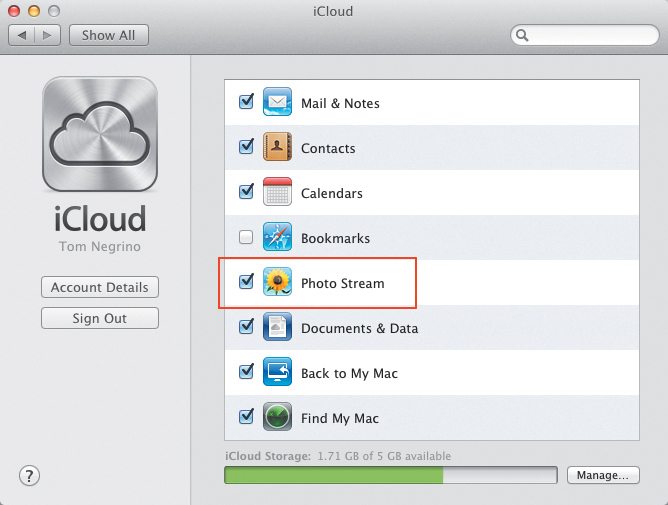
![]() You enable Photo Stream in the iCloud preference pane on a Mac.
You enable Photo Stream in the iCloud preference pane on a Mac.
or
On a PC, choose Start Menu > Control Panel > Network and Internet > iCloud ![]() .
.
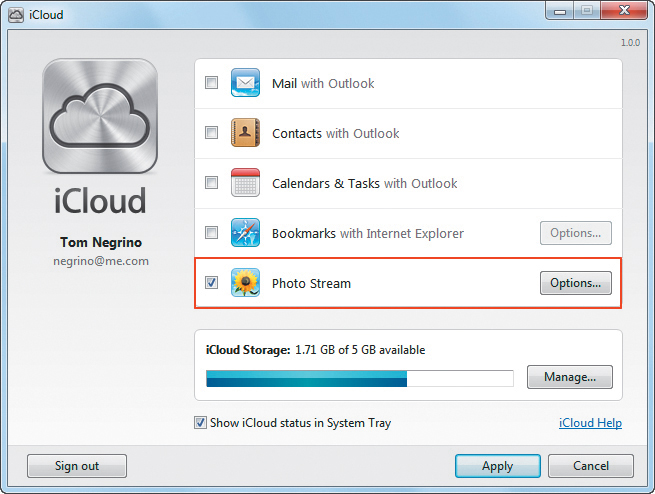
![]() On a Windows PC, you use the iCloud Control Panel to enable Photo Stream. Note the Options button.
On a Windows PC, you use the iCloud Control Panel to enable Photo Stream. Note the Options button.
2. On either platform, select the checkbox next to Photo Stream.
On the Mac, close the System Preferences window. On Windows, click Apply, then close the iCloud control panel.
3. (Optional) On a PC, you can choose to change the default folders Photo Stream uses for uploads and downloads. Click the Options button ![]() to display the Photo Stream Options dialog
to display the Photo Stream Options dialog ![]() . The dialog shows you the default paths to the download and upload folders; click the Change buttons next to either of those folders to switch them to a different location on your PC’s hard drive, navigate to the new locations, select the location, then click OK. Back in the Options dialog, click OK again.
. The dialog shows you the default paths to the download and upload folders; click the Change buttons next to either of those folders to switch them to a different location on your PC’s hard drive, navigate to the new locations, select the location, then click OK. Back in the Options dialog, click OK again.
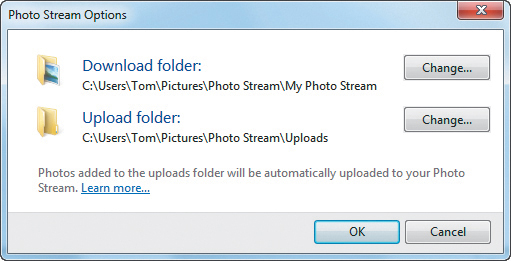
![]() On Windows, if you want to change the download and upload folders, you can do so in the Photo Stream Options dialog.
On Windows, if you want to change the download and upload folders, you can do so in the Photo Stream Options dialog.
Setting up Photo Stream on your iOS device
1. Choose > Settings > iCloud ![]() .
.
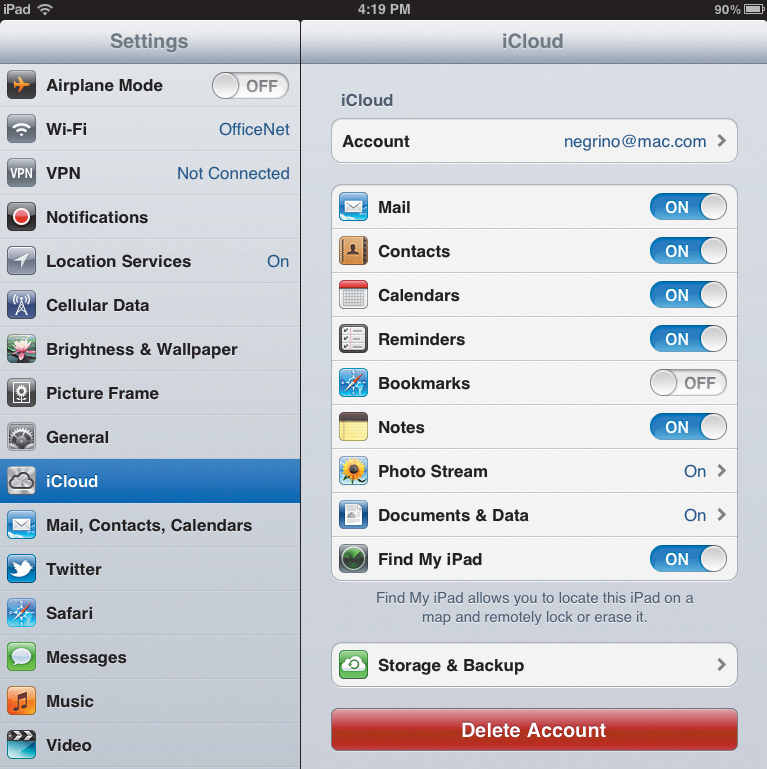
![]() Begin setting up Photo Stream on an iOS device in the iCloud Settings.
Begin setting up Photo Stream on an iOS device in the iCloud Settings.
2. Tap Photo Stream.
The screen changes to show the Photo Stream preferences ![]() .
.

![]() When you turn the Photo Stream switch to On, photos will automatically begin uploading and downloading.
When you turn the Photo Stream switch to On, photos will automatically begin uploading and downloading.
3. Slide the switch to On.
If your mobile device is connected to Wi-Fi, it will immediately begin downloading photos from the iCloud servers, and uploading new photos.
Tip
If you want to remove the Photo Stream from your iOS device, simply turn it Off in Settings. The Photo Stream photos will be removed from your iOS device, but will remain on the iCloud servers.
Working with Photo Stream in iPhoto
Pictures from Photo Stream appear in iPhoto ’11 (version 9.2.1 or later) in a new entry in the iPhoto sidebar ![]() . Clicking this entry in the sidebar shows you the pictures in your Photo Stream
. Clicking this entry in the sidebar shows you the pictures in your Photo Stream ![]() . It’s important to understand that pictures that appear in your Photo Stream haven’t yet been imported into your photo library; you’ll either need to enable Automatic Import or manually import the photos in a separate step, as described later in this section.
. It’s important to understand that pictures that appear in your Photo Stream haven’t yet been imported into your photo library; you’ll either need to enable Automatic Import or manually import the photos in a separate step, as described later in this section.
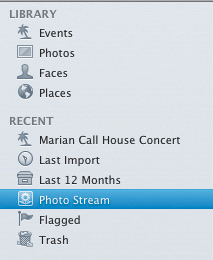
![]() Photo Stream appears as just another source in the iPhoto sidebar.
Photo Stream appears as just another source in the iPhoto sidebar.

![]() Clicking Photo Stream in the sidebar displays the photos in the iPhoto document window.
Clicking Photo Stream in the sidebar displays the photos in the iPhoto document window.
Photo Stream works with either iPhoto or Apple’s Aperture (see the “The Aperture Alternative” sidebar in this section), but not both at the same time. You have to choose which program you’ll use with Photo Stream, and turning the feature on in one program automatically turns it off in the other.
In either program’s preferences, you can decide whether or not you want the program to automatically import Photo Stream photos into the program’s Events, Photos, Faces, and Places, and, if you want, automatically upload those imported photos to the iCloud servers.
Since automatically pushing your photos to all your devices is the whole point of Photo Stream, why wouldn’t you want to automatically upload photos to iCloud? Remember that Photo Stream accepts full resolution photos from digital cameras, so if you’re shooting RAW format photos with your digital SLR, then importing them on a computer, iPhoto or Aperture will automatically upload all those pictures, which could potentially be many gigabytes in size. If you happen to live in an area with slow Internet connections or metered data, uploading those pictures could get very expensive (and if your iOS devices are on your Wi-Fi network, you’ll also incur bandwidth for downloading the resolution-optimized versions of those photos when they get pushed to your mobile devices). In that case, you might want to deselect the Automatic Upload checkbox in the Photo Stream preferences in your photo management application.
Tip
There’s also a caveat in allowing automatic upload to Photo Stream from your iOS device. If you’re the kind of person (and you know who you are) who could happen to shoot a potentially embarrassing picture with your iPhone, it will automatically be pushed up to iCloud and down to your iPad and computers. So if you share the latter devices with other people, they’ll immediately see the photographic evidence. See “Deleting Photos,” later in this chapter, for a possible remedy for your faux pas.
To set Photo Stream preferences
1. Choose iPhoto > Preferences > Photo Stream ![]() .
.
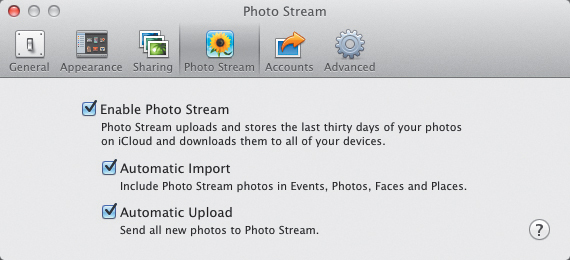
![]() Enable Photo Stream in iPhoto’s preferences.
Enable Photo Stream in iPhoto’s preferences.
or
Choose Aperture > Preferences > Photo Stream.
2. Select the Enable Photo Stream checkbox.
By default, the Automatic Import and Automatic Upload checkboxes are also selected. Deselect one or both, according to your needs.
To disable Photo Stream in your photo program
1. Open the Photo Stream preferences of your photo program.
2. Deselect the checkbox next to Enable Photo Stream.
The photo program warns you that all the photos in the Photo Stream view will be removed ![]() . You may already have imported all the photos into your photo library, but it’s still usually a good idea to click the Import Photos and Turn Off button. It won’t duplicate already imported pictures.
. You may already have imported all the photos into your photo library, but it’s still usually a good idea to click the Import Photos and Turn Off button. It won’t duplicate already imported pictures.
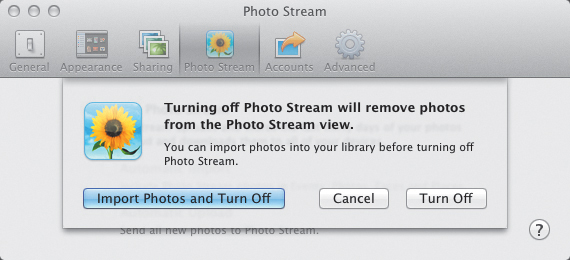
![]() If you turn Photo Stream off, iPhoto warns you that you will lose photos that you have not imported into your iPhoto library.
If you turn Photo Stream off, iPhoto warns you that you will lose photos that you have not imported into your iPhoto library.
To import Photo Stream items into an iPhoto or Aperture library
1. Click on Photo Stream in the sidebar of your photo management program.
2. Select individual photos in the Photo Stream. You can use the Shift key to select multiple contiguous photos, or use the Command key to select multiple noncontiguous photos.
3. Drag the selected photos to the Photos item in the sidebar ![]() .
.
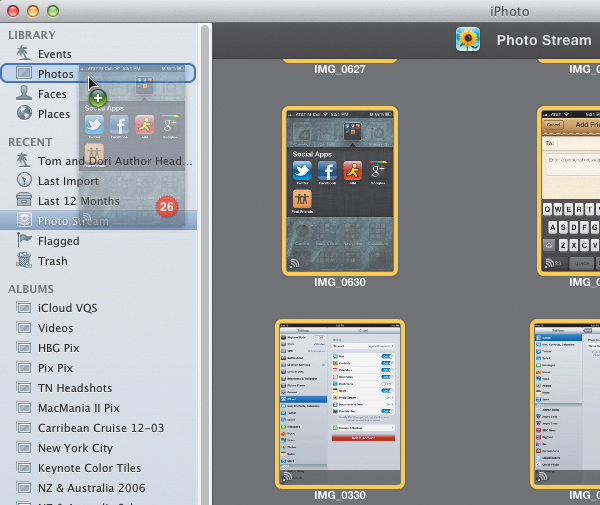
![]() To import photos from your Photo Stream into the iPhoto library, select them in the document window, then drag them to Photos in the sidebar.
To import photos from your Photo Stream into the iPhoto library, select them in the document window, then drag them to Photos in the sidebar.
If you inadvertently try to import photos that have already been imported, the program will let you know and allow you to decide what you want to do ![]() .
.
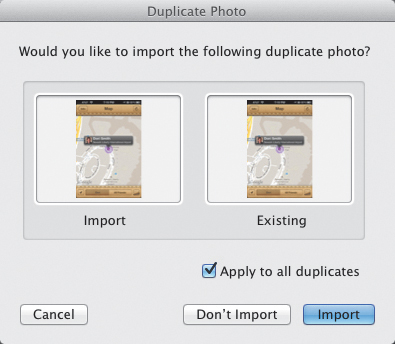
![]() iPhoto helps you deal with accidentally importing duplicate photos.
iPhoto helps you deal with accidentally importing duplicate photos.
Deleting Photos
Control of Photo Stream on iCloud isn’t very granular. You can’t view the Photo Stream on the iCloud website, and you can’t delete individual pictures from the Photo Stream. What you can do is reset your entire Photo Stream, deleting from the server or from individual devices.
To delete your Photo Stream photos from the iCloud server, you’ll use the iCloud website. To delete Photo Stream photos from your photo management program or your iOS devices, you simply turn off Photo Stream in the Preferences of the program or the iCloud Settings of the device. On a PC, you need to delete any photos in the Import folder.
If you want to completely delete all of the photos in your Photo Stream, you’ll need to first reset your Photo Stream on the iCloud website, then turn Photo Stream off from your various devices.
Tip
If you leave Photo Stream enabled on any of your devices, that device will refill iCloud with all of the photos you deleted from the website (at least the last 1,000 photos that were pushed to the mobile device).
To delete your Photo Stream on the iCloud website
1. Log in to the iCloud website.
2. Click your name on the iCloud homepage.
3. Click the Advanced button.
4. In the Advanced screen ![]() , click the Reset Photo Stream button.
, click the Reset Photo Stream button.
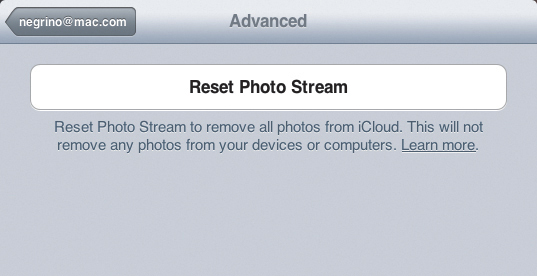
![]() You can delete your Photo Stream photos from the iCloud servers on the iCloud website.
You can delete your Photo Stream photos from the iCloud servers on the iCloud website.
A confirmation dialog will appear ![]() .
.
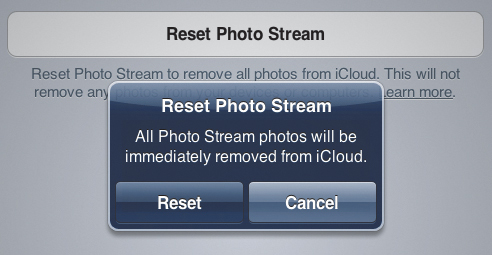
![]() As usual when you want to do something destructive, you’ll get a confirmation dialog.
As usual when you want to do something destructive, you’ll get a confirmation dialog.
5. Click Reset.
The photos will immediately be deleted from your Photo Stream.
Tip
If you had Automatic Import enabled in your Photo Stream settings in iPhoto or Aperture, your Photo Stream photos were imported into your program’s library, and will remain after you disable Photo Stream. You can, of course, manually delete any of these photos in the programs.
Tip
If you turn Photo Stream off on your iOS device, you’ll lose access to the Photo Stream on that device, and it will also stop uploading new pictures to the Photo Stream. If you turn Photo Stream back on, any new photos you shoot will start flowing to iCloud again, but any photos you took while Photo Stream was off won’t be uploaded.

